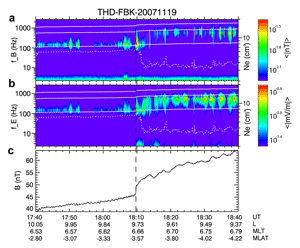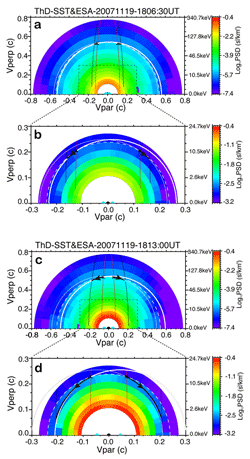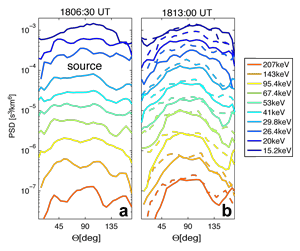
2012 THEMIS SCIENCE NUGGETS
The role of electrons during chorus intensification: Energy source and energy loss
by Huishan Fu, Swedish Institute of Space Physics, Uppsala
Introduction
The energetic electrons with positive anisotropic distributions (Tperp>Tpar) in the Earth’s plasma trough are believed to play important roles in generating the whistler-mode chorus. One of these roles, the energy loss process via pitch-angle diffusion, has been emphasized for many years. The other role, the energy source process, however, is usually neglected. In this study, we investigate comprehensively the dynamics of electrons, including the energy source and energy loss, during the chorus intensification processes, which are observed by THEMIS on November 19, 2007 in response to an interplanetary shock.
| Figure 1. Geomagnetic and interplanetary conditions in terms of (a) Dst, (b) Kp, (c) solar wind density, (d) solar wind velocity, (e) Z-component of the interplanetary magnetic field, and (f) solar wind dynamic pressure. Vertical dashed line in (c-f) indicates an interplanetary shock measured at the Earth’s bow shock nose. |
Results
At 1800 UT on 19 November 2007, an interplanetary shock hits the Earth’s magnetosphere (Figure 1), causing the sudden change of Dst and Kp. Meanwhile, THEMIS D, located in the morning-side plasma trough, observed the compression of the local magnetic field and the intensification of the chorus (Figure 2). This process lasts for about 12 seconds, much longer than the cyclotron period of the keV electrons (~ 1.0×10-3 s).
| Figure 2. Magnetic (a) and electric (b) components of chorus observed by THEMIS D on 19 November 2007. Solid white lines represent, from top to bottom, fce, 0.45 fce and 0.1 fce, where fce denotes the equatorial gyro-frequency of electrons. Dotted white line, scaled by the right-side Y-axis, denotes the plasma density derived from the spacecraft potential. (c), background magnetic field. |
By comparing the electron phase space density (PSD) before and after the shock, we investigate the energy loss processes for both the high (95 keV) and low (15 keV) energy electrons (Figure 3). We find that when the electrons are scattered by the wideband (0.1-0.45 fce) chorus from the higher-density region to the lower-density region along the diffusion curves (black arrows in Figure 3), their kinetic energies can be transferred to the chorus; this energy loss is more efficient for the low energy (15 keV) electrons as they have larger density gradient and energy drop along the diffusion curves.
| Figure 3. Phase space density (PSD) of electrons measured before (a, b) and after (c, d) the shock. Dotted lines in Figure 3a-3b represent the resonance curves of the 150 Hz (red) and 100 Hz (black) chorus, while in Figure 3c-3d, they represent the resonance curves of the 800 Hz (red) and 200 Hz (black) chorus. The white solid curves represent the diffusion curves produced by the single-frequency wave, while the thick black lines denote the diffusion curves produced by the wideband wave. They are similar in Figure 3a-3c, but quite different in Figure 3d. |
The model of betatron acceleration is applied to reproduce the electron PSD after the shock (Figure 4). The good agreement between modeling results (solid lines in Figure 4) and observations (dashed lines in Figure 4) suggest that the betatron acceleration can be an effective mechanism for supplying the energy source. However, we cannot exclude the contributions from the drift-resonance as the ULF waves, well correlated with the fluxes of energetic electrons, are also observed. The suprathermal electrons injected from the magnetotail are absent, meaning that they are not the energy source in this event.
| Figure 4. PSD evolution from 1806:30 UT (before shock) to 1813:00 UT (after shock). Solid lines represent the observations of THEMIS D; dashed lines show the results from the modeling. |
Conclusion
The main conclusions of this study can be summarized as follows:
- Dynamics of electrons, including the energy source and energy loss, are studied comprehensively during the shock-driven intensification of choruses.
- Energy source process is adiabatic, while energy loss process is nonadiabatic.
- Energy source process includes the betatron acceleration and the drift-resonance with ULF waves, but not the magnetotail injection in this event.
- Energy loss process, referring to the pitch-angle diffusion, is more efficient for the low energy (15 keV) electrons as they have larger density gradient and energy drop along the diffusion curves.
- Energetic electrons act as the intermediate; they transfer energies carried by the interplanetary shock to the chorus.
References
Biographical Note
Huishan Fu is a postdoc at Swedish Institute of Space Physics, Uppsala. His research interests are radiation belts and magnetotail dynamics, and the connection between them (see https://sites.google.com/site/huishanfu/home for more information).
 Please send comments/suggestions to
Emmanuel Masongsong / emasongsong @ igpp.ucla.edu
Please send comments/suggestions to
Emmanuel Masongsong / emasongsong @ igpp.ucla.edu



